|
November 2013 - February 2014 |
| |
|
|
 |
|
 |
| |
Publisher: Chairman Gong-Ru Lin Editors: Professor
Chao-Hsin Wu, Ms. Hsiao-wen Lin March 30, 2014 |
| |
|
 |
|
Congratulations to GIPO Professor Jr-Hau He on being awarded the “2013 outstanding youth electrical engineer” prize from
the Chinese Institute of Electrical Engineering.
Congratulations! GIPO Professor Jian-Jang Huang receives the title of "2014 SPIE Fellow".
Congratulations to the following students/advisers on being awarded the following student thesis prizes.
|
Year |
Winner |
Prize |
Adviser |
|
2013 |
Hsiao-Lun Wang |
The 3rd , 2013 youth thesis prize of the Chinese Institute of Electrical Engineering |
Chao-Hsin Wu |
|
2013 |
Chung-Lun Wu |
2013 science and technology scholarship, China Technical Consultants Inc. Foundation |
Gong-Ru Lin |
|
2013 |
Yung-Hsiang Lin |
The 1st, doctoral thesis, 2013 Lam Research Award |
Gong-Ru Lin |
|
2013 |
Hsiao-Lun Wang |
Excellent, master’s thesis, 2013 Lam Research Award |
Chao-Hsin Wu |
|
2013 |
Ming-Heng Tsai |
Excellent, master’s thesis, 2013 Lam Research Award |
Cheewee Liu |
|
|
 |
|
 |
|
| |
|
 |
|
November “Photonics Forum” Highlights
(Compiled by Li-Chi Yao) |
|
|
3:30 pm, Fri., Nov. 1st, 2013 |
|
Speaker: |
Professor Wood-Hi Cheng (Department of Photonics, National Sun Yat-Sen University) |
|
Topic: |
The Art and Science of Packaging High-Coupling Photonics Devices and Modules |
| |
Professor Wood-Hi Cheng visited GIPO on Nov. 1
(Fri.) and delivered a speech concerning "The Art and Science of Packaging High-Coupling Photonics Devices and Modules" at lecture theater
101, Barry Lam Hall. His speech was rich in content, and the professor interacted well with students. GIPO teachers and students attended the event with enthusiasm and learned a great deal. |
| |
|
 |
|
Professor
Wood-Hi Cheng (right) and
Professor Snow H. Tseng (left),
the host of the speech |
|
|
|
3:30 pm, Fri., Nov. 29th, 2013
|
|
Speaker: |
Professor Charles W. Tu
(Distinguished Professor, ECE Dept., University of California) |
|
Topic: |
Bandgap Engineering and Device Applications of Dilute Nitrides |
| |
Professor Charles W. Tu visited GIPO on Nov. 29
(Fri.) and delivered a speech concerning “Bandgap Engineering and Device Applications of Dilute Nitrides” at lecture theater
101, Barry Lam Hall. His speech was fascinating, and the professor interacted well with students. GIPO teachers and students attended this event with enthusiasm and gained a lot from it. |
|
|
|
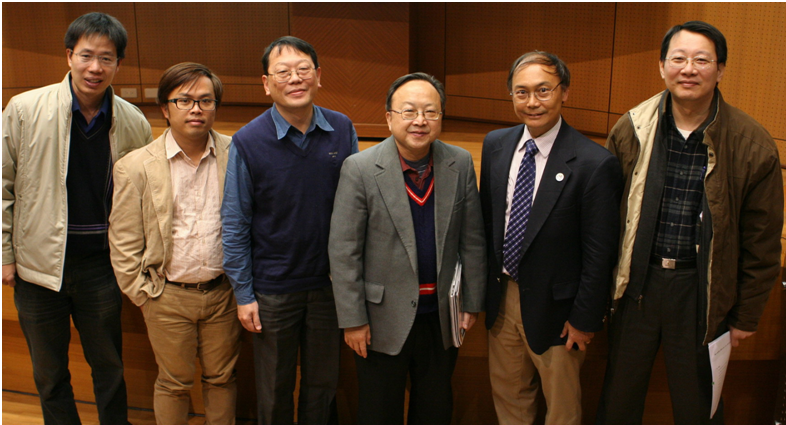 |
|
A group photo of Professor Charles W. Tu (the 2nd, right) and GIPO
teachers |
|
|
2013 Photonics Forum & Counseling Committee
(Compiled by Li-Chi Yao) |
|
Time: |
8:40 am ~ 4:40 pm,
Fri., Dec. 13th, 2013 |
|
Place: |
Lecture theater
101, Barry Lam Hall |
|
|
GIPO
held the “2013 Photonics Forum &
Counseling Committee” on Dec. 13 (Fri.) 2013. Several famous scholars from the USA, Hong Kong and Taiwan were invited to the forum to deliver speeches. Hereunder is the information concerning these speeches: |
|
|
|
|
|
09:00~09:50 |
|
Speaker: |
Professor Connie J. Chang-Hasnain (University of California at Berkeley, USA) |
|
Topic:
|
Nanophotonics Using III-V Nanopillars Grown on Silicon |
|
|
|
|
|
10:10~11:00 |
|
Speaker: |
Professor Xi-Cheng Zhang (University of Rochester, USA) |
|
Topic: |
Challenge and opportunity for remote sensing with THz waves |
|
|
|
|
|
11:10~12:00 |
|
Speaker: |
Professor Kei-May Lau (Hong Kong University of Science and Technology, Hong Kong) |
|
Topic: |
LED on Silicon (LEDoS) for Intelligent Lighting and Display |
|
|
|
|
|
14:00~14:50 |
|
Speaker: |
Professor Sien Chi (National Chiao Tung University) |
|
Topic: |
Ultra-High Capacity V/W-band Optical/Wireless Systems Enhanced with Digital Signal Processing, Poems and Optics |
|
|
|
|
|
15:10~16:40 |
|
Speaker: |
Professor Din-Ping Tsai (National Taiwan University) |
|
Topic: |
Plasmonic nano bumps, vertical U-shape ring and toroidal metamaterials |
| |
|
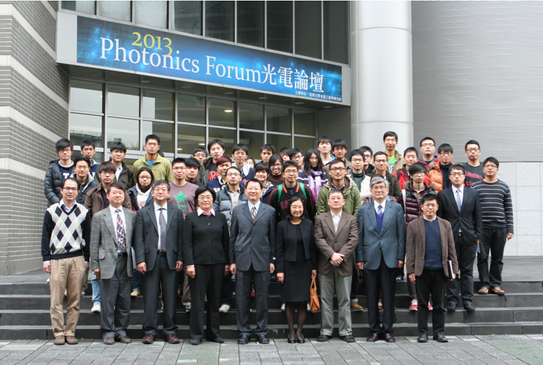 |
|
A group photo of professors, from left to right:
Vice Chairman Jian-Jang Huang, Professor Sheng-Lung Huang, Professor Xi-Cheng Zhang, Professor Connie J. Chang-Hasnain, Chairman Gong-Ru Lin, Professor Kei-May Lau, Professor Chih-Chung Yang, Professor Hung-Chun Chang, and Professor Yih-Peng Chiou |
|
|
December & January “Photonics Forum” Highlights
(Compiled by Li-Chi Yao) |
|
|
3:30 pm, Fri., Dec. 20th, 2013 |
|
Speaker: |
Professor Devki N. Talwar (Chair of Department of Physics, Indiana U of Pennsylvania (IUP)) |
|
Topic:
|
Unusual properties of SiC and III-N materials |
| |
Professor Devki N. Talwar visited GIPO
on Dec. 20 (Fri.) and delivered a speech concerning “Unusual properties of SiC and III-N materials” at lecture theater
105, EE-II Building. The content of his speech was fascinating and the professor interacted well with students. GIPO teachers and students participated in this event with enthusiasm and gained a lot from it. |
|
|
|
 |
|
Professor Devki N. Talwar
(left) and Professor Snow H.
Tseng (right), the host of this
speech |
|
|
|
3:30 pm, Fri., Jan. 3rd, 2014 |
|
Speaker: |
Professor Ci-Ling Pan (Physics Department of National Tsing Hua University) |
|
Topic:
|
Progress in Short-Pulse Yb-doped Fiber Oscillators and Amplifiers |
| |
Professor Ci-Ling Pan visited GIPO
on Jan. 3 (Fri.) and delivered a speech concerning “Progress in Short-Pulse Yb-doped Fiber Oscillators and Amplifiers” at lecture theater
101, Barry Lam Hall. GIPO teachers and students learned a great deal from Professor Pan’s fascinating talk, and the professor interacted well with students. |
| |
|
 |
|
Professor Ci-Ling
Pan (right) and Professor Snow
H. Tseng (left), the host of
this speech |
|
~ 2013 GIPO year-end afternoon-tea party ~
(Time: Dec. 27th,
2013; Location: the 3rd floor courtyard of Ming-Da
Hall, EECS, NTU)
Compiled by Ting-Hao Chen,
President of GIPO Student
Association
The annual GIPO year-end afternoon-tea party was held at the end of 2013. There were huge crowds of people - over 200 GIPO teachers and students attended, and the courtyard was really crowded. In spite of the cold-front, partygoers soon warmed the whole venue with their enthusiasm.
This year, we specifically scheduled the party at the completion of seminars, so that everyone could come directly after having taken the seminars, and the turn-out proved that we were right.
To reward students for all their hard work during the past year, we prepared delicious afternoon-tea foods, and also provided singing, magic shows, quizzes with prizes, and lottery draws. We prepared many kinds of prizes this year, including some which may surprise you. Although there was no particularly valuable prize, there were lots of ordinary prizes, since we wanted more students to win and have a happier new year.
At the start of the party, we were honored to have Chairman Gong-Ru Lin address partygoers. After that,
Xue-Qian You, a GIPO student, who holds the title of “GIPO’s William Wei”, a composer and singer, to sing for us. Everyone enjoyed his performance and felt he was really worthy of that title.
Next, Ching-Hung Chen, the 25th president of NTU Magic Club and the runner-up of TMA Magic Convention, produced a fantastic magic show. His tricks were so amazing that during his show many students had could not stop saying “wow” and forgot to close their mouths. We felt like we were witnessing miracles.
And last, was the most anticipated quiz and lottery. Partygoers burst into thunderous cheers when the cute, humorous and interesting host took charge of the event. At the start of the guess-the-title-of-the-song game, students rushed to raise their hands and give the answer. However, there were too many raised hands to choose from, and we had no alternative but to change the rule from raising hands to whoever was first to seize the host. And, not surprisingly, the host was snatched by many crazed participants.
In the end, it didn’t really matter if someone didn’t have a chance to guess any title because the last and best event – the lottery - soon followed. During the lottery, as the host was drawing lots, everyone held his/her breath as well as ticket, entertaining every possible hope, and waiting for the host to announce the next lucky person. Eventually, all the prizes were given away. We would like to congratulate those who won prizes and encourage those who didn’t to come back again next year.
Finally, we would like to thank GIPO teachers and office staff for their kind support and generous help, and thank all of you who came to participate in this party; looking forward to seeing you next time.
|
 |
|
 |
|
| |
|
 |
|
~ 2013 Ph.D. Student Academic Exchange with Nanjing University ~
(Time: Oct. 8~14, 2013; Location:
Nanjing University and Yangzhou University)
Composed by Chung-Lun Wu, GIPO
Ph.D. student and the leader of GIPO student team
The 6th Cross-Strait Ph.D. Student Forum on Photonic Science and Technology, organized by Nanjing University and co-organized by Yangzhou University, was held at Yangzhou City on Oct. 8, 2013.
GIPO, NTU, sent 11 excellent doctoral students, 1 post-doctoral researcher,
Chairman Gong-Ru Lin, Vice Chairman Jian-Jang
Huang, Prof. Hoang-Yan Lin, and Prof. Yuh-Renn Wu to attend this event.
This was my
second time attending the forum, and I was honored to be the leader of the GIPO student team. I was responsible for arranging the schedule of the forum with Nanjing
University student representative Mingjie Wan. GIPO had held 4 pre-forum meetings before departure. For these meetings, Ms. Hsiao-Wen Lin carefully completed the schedule and arrangements; her hard-work and dedication were instrumental in the success of the pre-forum meetings, and the forum itself.
Since we were guests, and only visiting the hosts at Yangzhou City, nearly everything including the running of meetings, plans for meeting venues, accommodations, and visits to cultural sites, were arranged by Nanjing
University and Yangzhou University Therefore, we only had to take care of our own study-reports.
We would especially like to thank
Deputy Dean
Zhen-Lin Wang, Nanjing
University,
Deputy Dean
Jing-Guo Hu, Yangzhou
University, and Ms. Xiao-Xia Jin, Nanjing
University, for providing us with an easy and comfortable meeting environment.
There were 2
invited reports and 27 doctoral-student reports.
Of all the reports, Shining Zhu's, fellow of the Chinese Academy of Sciences, was especially splendid. Using the change of optical refractive index and the experimental method, he simulated the distortion gravity creation on a beam of light. His report showed creative research, which impressed and inspired students greatly.
Chairman Gong-Ru Lin's report was an incisive analysis of carbon series materials' mode-locking laser work. Chairman Lin provided an easy-to-understand description of mode-locking theory to students and the report generated many interesting questions from students.
In the following doctoral-student interaction session, everyone introduced his/her own research to all students. Generally speaking, Mainland students' research is more involved in fundamental theories than Taiwanese students' research, and the questions they raised were more concerning theories as well. Nevertheless, Taiwanese students' research
is more involved in technological application and the development of photonics components. The questions they raised were more related to practical application. In conclusion, both sides were important in their own way, and well worth learning from.
One more thing was worth noting. Since we ordinarily spent most of our time in our own studies, we’ve had little time to spend with students from other laboratories. GIPO doctoral-students did not even know each other well. However, by virtue of this interaction, did we not exchanged information on studies with Mainland students, but also had an opportunity to interact with other GIPO students and got to know students from other GIPO laboratories and their research, which was of great benefit to us.
After the 2-day's forum, Nanjing
University arranged some cultural and industrial visits for us. While visiting Yangzhou Sina Optical Company, which specialized in optical coating, we witnessed the application of what we had learned - the photonic crystal theory - in industry. Afterwards, we visited some famous spots in Yangzhou, Suzhou and Hangzhou, including boating on lake-boating and touring ancient yards, which were delightful to us.
During the last day of the forum, Nanjing
University arranged a laboratory visit for us, which showed us the excellent equipment and superior deployment of their laboratories. We were deeply impressed and realized that the Physics
School of Nanjing University was indeed one of the top Mainland colleges.
Everyone who attended the forum cherished our short time together; many Nanjing
University students came to see us off for our departure. And everyone gained a lot during these days. I do wish that the forum could last forever, and believe that this valuable educational interaction will become better and stronger.
|
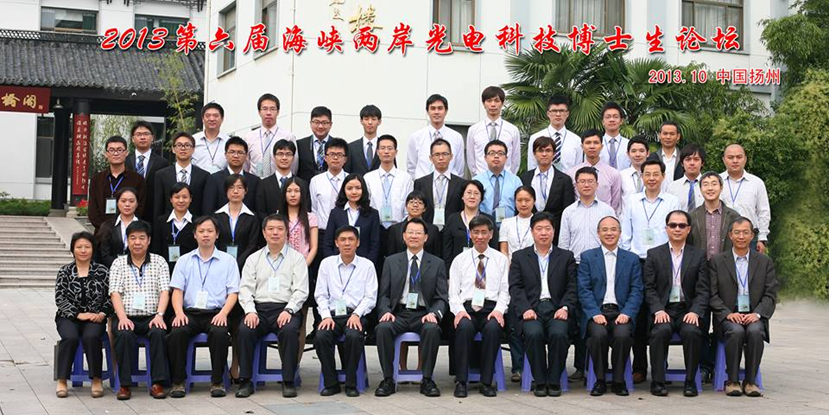 |
|
A group photo of
all attendants of the 2013
Cross-Strait Ph.D. Student Forum
on Photonic Science and
Technology |
|
|
 |
|
 |
|
| |
|
 |
Temperature
dependence of Raman scattering in bulk 4H-SiC
with different carrier concentration
Professor Zhe-Chuan Feng's group
Graduate Institute of Photonics and
Optoelectronics, National Taiwan University
Raman spectra of three bulk 4H-SiC wafers with
different free carrier concentration were measured in 80-873K. As temperature
increases, Raman peaks of most optical phonon modes show monotonous down shift.
An anomalous non-monotonous variation with temperature, was observed in the A1
longitudinal optical (LO) mode from doped samples. Two methods of theoretical
fitting, one-mode (LO-plasma coupled (LOPC) mode) and two-mode (A1(LO+LOPC)
fitting, are employed to analyze this anomalous phenomenon. Theoretical
simulations for temperature dependent Raman spectra using two methods are
critically examined.
|
 |
|
Figure 1. Raman spectra of three 4H-SiC samples with different doping levels at temperature varying from 80 K to 873 K. |
|
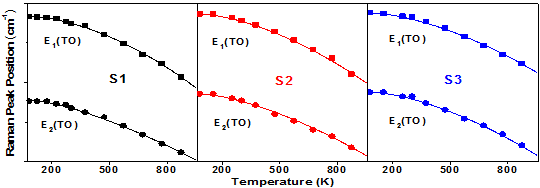 |
|
Figure 2. Theoretical fitting results of E1(TO) and E2(TO) mode peak positions of three 4H-SiC samples. |
|
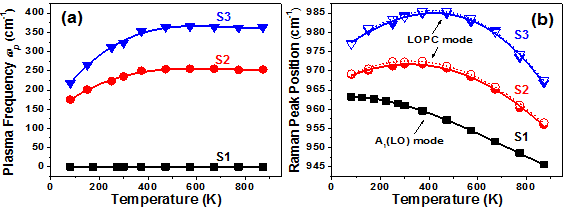 |
|
Figure 3. Temperature dependence of (a) plasma frequency ωp (b) experimental results (solid line) and theoretical calculation (short dot line) of LOPC mode peak positions, in one-mode method. |
Confocal micro-Raman spectroscopy measurements at
temperature varying from 80 K to 873 K and theoretical analyses on bulk 4H-SiC
wafers, undoped, medium doped and high doped, were done. Down shift of E2
(TO) and E1 (TO) phonon scattering modes is explained through phonon
frequency function with temperature. Anomalous variation of A1(LO)
mode in doped 4H-SiC stems from the coupling between LO phonons and plasma,
which forms the LOPC mode. Two methods, one-mode and two-mode methods, are
applied to analyze variation of A1(LO) mode. These two method fits
have appeared in the literature for many years but no judgment on which one
being more reliable was given yet so far. We have demonstrated clearly that the
two-mode method is untenable in interpreting anomalous variation of A1(LO)
mode with temperature, while the one LOPC mode simulation is in good accordance
with experimental results. The non-monotonous variation of blue-red shifts with
temperature for LOPC mode from doped 4H-SiC could be explained by the influence
from ionization process of impurities on the process of Raman scattering. A
quantitative description on temperature dependent Raman spectra for doped 4H-SiC
is achieved in this paper, matching well to experimental data.
Optics Express, Vol. 21,
no. 22, 26475–82 (2013).
The application
of IR radiation in biotechnology and cancer
therapy
Professor Si-Chen Lee
Graduate Institute of Photonics and
Optoelectronics, National Taiwan University
We have developed different types of innovative
narrow bandwidth infrared (IR) radiation emitters, including tri-layers Au/SiO2/Au
waveguide thermal emitter (WTE) and tri-layers Ag/SiO2/Ag plasmonic
thermal emitter (PTE), theirs emission wavelengths were varied from 3 to 10 μm
[1-3]. We used the narrow band IR emitters to irradiate the
E. Coli and lung cancer cells and investigate its effect. In 2011, ” The
effect of narrow bandwidth IR radiation on the growth of Escherichia coli,” was
published in in Applied Physic letter [4]. The diameters of
E. Coli were affected by IR radiation for 24 hours with PTE peak
wavelengths at 3, 3.5, 4, 4.5, and 5 μm, but not other wavelength as shown in
Fig. 1. It was identified to be caused by the increased expression of the outer
membrane protein OmpA and OmpF, implies nutrition transport and metabolic
pathways of
E. Coli were significantly regulated by narrow bandwidth IR radiation.
Furthermore, We have cooperated with Prof. Juan
(Department of life science, NTU) and found that 3~5 μm IR radiation can induce
the A549 lung cancer cell swelling, inhibit the phosphorylation of cyclin B1 and
the arrest of G2/M cell cycle progression as shown in Fig. 2. [5]. This study
also exhibited that IR radiation triggered ATM/ATR-p53-p21 axis in response to
DNA damage, leaded to the formation of 53BP1 and
g-H2AX
nuclear foci, implies that IR radiation induced the DNA repair system to fix the
DNA damage. Additionally, we have investigated that IR radiation with WTE peak
wavelengths at 4.1, and 5.0 μm can induce the collapse of mitochondrial membrane
potential of HeLa cervical cancer cells to enhance the therapeutic effects of
Paclitaxel.
In summary, The IR radiation could be used to
enhance the growth of
E. Coli for biotech application, or combined with chemotherapy to treat
cancer cells. This technology has potential to be applied in clinical cancer
therapy in the future.
|
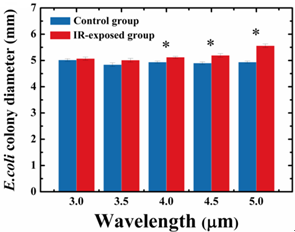 |
 |
|
Figure 1. The colony diameters of E.coli treated with different wavelengths of PTE for 24 hours [5]. |
Figure 2. The genes related to G2/M transition of A549 cells treated with the 3~5
μm IR radiation (MIR) for 48 hours [6]. |
References
1. Wu, Y.-T., et al., Narrow Bandwidth Midinfrared Waveguide Thermal
Emitters. Photonics Technology Letters, IEEE, 2010.
22(15): p. 1159-1161.
2. Tsai, M.-W., et al., High performance midinfrared narrow-band plasmonic
thermal emitter. Applied Physics Letters, 2006.
89(17): p. 173116-3.
3. Chen, H.-H., et al., Two infrared emission modes with different
wavelengths and orthogonal polarization in a waveguide thermal emitter.
Journal of Applied Physics, 2012.
112(7): p. 074325-5.
4. Tsai, S.-R., et al., The effect of narrow bandwidth infrared radiation on
the growth of Escherichia coli. Applied Physics Letters, 2011.
99(16): p. 163704.
5. Chang, H.Y., et al., Middle infrared radiation induces g(2)/m cell cycle
arrest in a549 lung cancer cells. PLoS One, 2013. 8(1): p. e54117.
Simulating light
transmission through
a metallic thin film
perforated with 2D
periodic array of
multiple-slit
apertures
Professor Hung-chun
Chang
Graduate Institute of
Photonics and
Optoelectronics,
National Taiwan
University
The phenomenon of
extraordinary
transmission through
periodically arranged
sub-wavelength holes in
metal films has
attracted considerable
interest during past
decades. The main
mechanisms responsible
for this phenomenon have
been widely believed to
be the excitation of
surface plasmon
polaritons (SPPs), or
the surface
electromagnetic (EM)
modes, and Wood’s
anomalies (WAs) set up
by periodically arranged
holes. In addition, it
has been shown that the
shape of the aperture,
resulting in shape
resonances (SRs), has a
strong effect on the
transmission spectra. In
this work, we study the
optical properties of
differently shaped
apertures composed of
one to three horizontal
slits, named x-arm
slits, and one vertical
slit, named y-arm
slit. Figure 1(a) shows
the geometry of a unit
cell of one
sub-wavelength metallic
structure example we
study. The metal
(silver) film with
thickness 75 nm is
coated on a silicon
substrate. An in-house
developed 3D
finite-difference
time-domain (FDTD)
method numerical model
is used to simulate the
EM field distributions
and transmission spectra
under normal incidence
of light. Periodic
boundary conditions are
applied to the xz
and yz planes to
simulate a square
periodic array of
apertures. The SR
wavelength might
dominantly depend on the
slit length. But for
more complex-shaped
apertures, the SR paths
may have some
ambiguities to be
estimated by the
modified cutoff
wavelengths of the
rectangular waveguide
(i.e., λres
= 2neffLres/m,
where is the effective
refractive index, Lres
is the resonant length,
and m is an
integer) due to the
slight difference of the
Lres
between those possible
contours. We have found
that analyzing the
near-field features is
helpful in
distinguishing the SR
modes. For example, the
modulus of the electric
field, |E|,
defined by
is the effective
refractive index, Lres
is the resonant length,
and m is an
integer) due to the
slight difference of the
Lres
between those possible
contours. We have found
that analyzing the
near-field features is
helpful in
distinguishing the SR
modes. For example, the
modulus of the electric
field, |E|,
defined by
 ,
contours clear geometry
of the resonant length.
Within the SR paths, the
distribution of the
phase component parallel
to the polarization of
the incident light
(e.g., φEx
under x-polarized
light) is quite
homogeneous and the
phase component along
the propagation
direction, φEz,
exhibits a 180。jump
at the center of the
slit width. By focusing
on the anti-phase
property of φEz
along the SR contours
and the symmetry
requirement preserved
for certain polarization
state of light, those SR
paths that cannot meet
the above two criteria
together are obviated
and the possible right
ones are left. In order
to testify the validity
of such principles in
determining the SR
paths, we design a set
of apertures with
onefold or twofold
mirror symmetry,
composed of x-arm
slits and one y-arm
slit, as shown in Fig.
1(b). We find the
FDTD-obtained
field-profile
predictions agree well
with the real SR modes,
which are validated by
the near-field analyses.
Moreover, we discuss how
the separation distance
between slit elements in
the apertures affects
the SR wavelength under
specific incident-wave
polarization, showing
how the coupling between
adjacent slits would
play a role in the
variation of the
spectra, as shown in
Fig. 1(c). By delicately
studying the properties
of such factors and how
they interact, we could
manipulate the spectra
with an additional
degree of freedom, which
could be important to
structures with
multi-holes or
multi-slits in one unit
cell. (Hui-Hsin Hsiao
and Hung-chun Chang, in
META’13 Abstracts,
pp. 161–162, March
18–22, 2013.) ,
contours clear geometry
of the resonant length.
Within the SR paths, the
distribution of the
phase component parallel
to the polarization of
the incident light
(e.g., φEx
under x-polarized
light) is quite
homogeneous and the
phase component along
the propagation
direction, φEz,
exhibits a 180。jump
at the center of the
slit width. By focusing
on the anti-phase
property of φEz
along the SR contours
and the symmetry
requirement preserved
for certain polarization
state of light, those SR
paths that cannot meet
the above two criteria
together are obviated
and the possible right
ones are left. In order
to testify the validity
of such principles in
determining the SR
paths, we design a set
of apertures with
onefold or twofold
mirror symmetry,
composed of x-arm
slits and one y-arm
slit, as shown in Fig.
1(b). We find the
FDTD-obtained
field-profile
predictions agree well
with the real SR modes,
which are validated by
the near-field analyses.
Moreover, we discuss how
the separation distance
between slit elements in
the apertures affects
the SR wavelength under
specific incident-wave
polarization, showing
how the coupling between
adjacent slits would
play a role in the
variation of the
spectra, as shown in
Fig. 1(c). By delicately
studying the properties
of such factors and how
they interact, we could
manipulate the spectra
with an additional
degree of freedom, which
could be important to
structures with
multi-holes or
multi-slits in one unit
cell. (Hui-Hsin Hsiao
and Hung-chun Chang, in
META’13 Abstracts,
pp. 161–162, March
18–22, 2013.)
|

(a) |
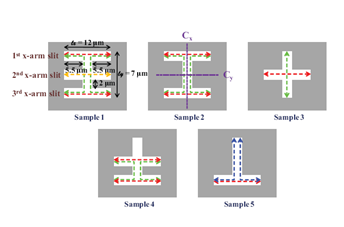
(b) |
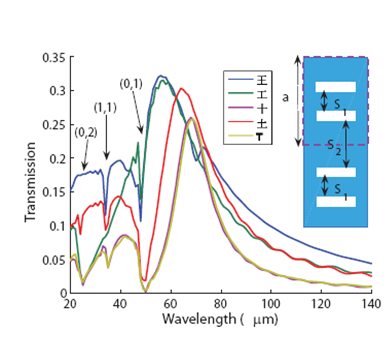
(c) |
|
Figure 1. (a)
The unit cell
and the
near-field plane
cut in our
simulation. (b)
Top view and
structural
parameters of
samples 1–5. (c)
Transmission
spectra with an
y-polarized
light under
normal
incidence. The
inset shows two
adjacent unit
cells with
separation
distances
between the x-arm
slits, s1
and s2,
specified. |
Strain reduction and
crystal improvement of
an InGaN/GaN
quantum-well
light-emitting diode on
patterned Si (110)
substrate
Professor
C. C. (Chih-Chung)
Yang's group
Graduate Institute of
Photonics and
Optoelectronics, National
Taiwan University
The comparisons of the
morphology, material
property, and optical
characteristics of a
crack-free InGaN/GaN
quantum-well light-emitting
diode (LED) structure of
completely coalesced
overgrowth on an
a-axis-oriented
one-dimensional
trench-patterned Si (110)
substrate with the other two
samples grown on flat Si
(110) and Si (111)
substrates are demonstrated.
This sample on patterned Si
(110) substrate shows the
highest crystal quality,
weakest tensile strain,
largest internal quantum
efficiency, strongest LED
output intensity, lowest
device resistance, and
smallest spectral shift
range in increasing
injection current. The small
spectral shift range
indicates the weak
quantum-confined Stark
effect. The advantages of
this sample are attributed
to the small lattice
mismatch between Si and GaN
along the
m-axis, the reduced
thermal stress along the
m-axis, and the
minimized upward-propagating
dislocation density. Figure
1 shows the cross-sectional
scanning electron microscopy
(SEM) images of the sample
with patterned Si (110)
substrate (sample A). One
can see the preserved
trenches in the Si
substrate. Figure 2 shows
the plan-view SEM images of
the three samples: (a)
patterned Si (110)
substrate-sample A, (b) flat
Si (110) substrate-sample B,
and (c) flat Si (111)
substrate-sample C. Only
sample A is crack-free.
Figure 3 shows the Raman
scattering spectra of the
three samples. Sample A is
strain free. Figure 4 shows
the LED output intensities
(left ordinate) and spectral
peak energies (right
ordinate) as functions of
injection current of the
three samples. Sample A has
the highest output intensity
and the smallest spectral
shift.
|
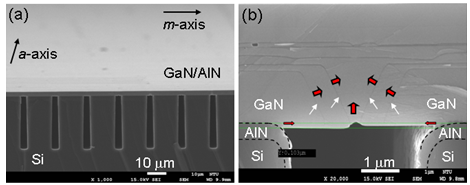 |
|
Fig. 1
Cross-sectional SEM
images of the sample
with patterned Si
(110) substrate. |
|
 |
|
Fig. 2 Plan-view
SEM images of the
three samples: (a)
patterned Si (110)
substrate, (b) flat
Si (110) substrate,
and (c) flat Si
(111) substrate. |
|
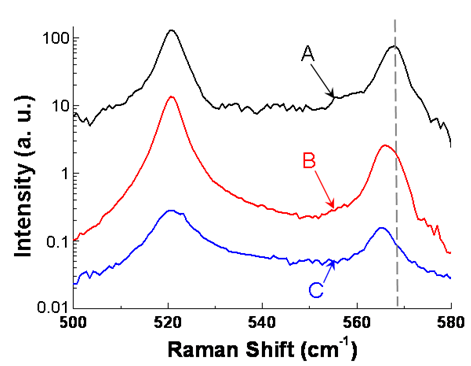 |
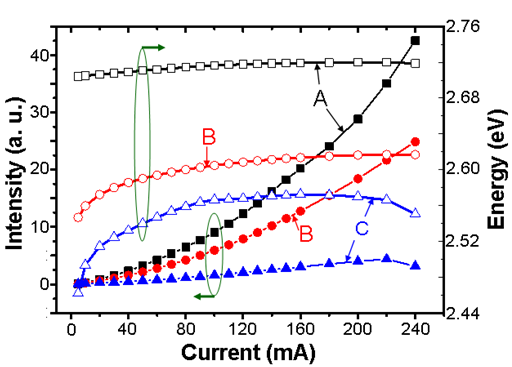 |
| Fig. 3 Raman
scattering spectra
of the three
samples. |
Fig. 4 LED
output intensities
(left ordinate) and
spectral peak
energies (right
ordinate) of the
three samples.
|
Surface plasmon
coupling with a radiating dipole near an Ag
nanoparticle embedded in GaN
Professor Y. W. Kiang’s
Laboratory
Graduate Institute of Photonics and
Optoelectronics, National Taiwan University
The localized surface plasmon (LSP) coupling
behaviors of a radiating dipole with an Ag nanosphere (NS) embedded in GaN are
evaluated based on a numerical algorithm, which takes account of the induction
of the LSP resonance on the Ag NS by the radiating dipole and the feedback of
the LSP resonance to the radiating behavior of the dipole. In particular, we
compute the enhancements of dipole strength and radiated power through such a
coupling process for the radiating dipoles oriented along the radial and orbital
directions with respect to the Ag NS. The enhancements of radiated power of a
radial and an orbital dipole are induced through the coupling with the LSP
dipole and higher-order resonance, respectively. These results are interpreted
with the interference behaviors between the radiations of the source dipole and
the LSP mode of the Ag NS.
|
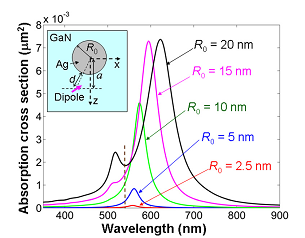 |
|
Fig. 1. Absorption cross sections as functions of wavelength of an Ag NS of various radii at R0 = 2.5, 5, 10, 15, and 20 nm. The insert shows the geometry of the LSP coupling system, including an embedded Ag NS with radius R0 centered at the coordinate origin and a radiating dipole located at (x, 0, a), which is represented by a thick (pink) arrow. |
|
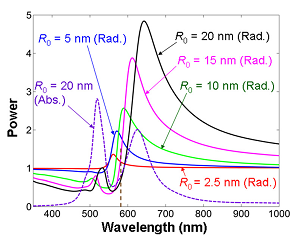 |
|
Fig. 2. Normalized radiated powers (Rad.) as functions of wavelength in the case of a radial dipole for d = 30 nm. The normalized absorbed power (Abs.) as a function of wavelength for R0 = 20 nm is also plotted. |
Properties and
device application of GaAsPSb lattice matched to
GaAs
Professor Hao-Hsiung Lin
Graduate Institute of Photonics and
Optoelectronics, National Taiwan University
GaAsPSb is an alloy consisting of three binaries;
GaP, GaAs, and GaSb. The bonds of the three binaries are highly mismatched in
length. As a result, the bonds undergo strong stretching and bending when they
are packed into the alloy lattice. Although the strong bond distortion leads to
difficulty in epitaxial growth, the distortion, especially the bending, strongly
affects the electronic band structure. Theoretical calculation showed that the
randomly bending increases the bowing of the valence band. This property has
been studied using photoreflectance spectroscopy and applied to heterojunction
bipolar transistor (HBT) with low turn-on voltage. Fig. 1 shows the transition
energies of conduction band to heavy hole, light hole and spin orbit bands of
GaAs0.64P0.19Sb0.17. From the transition
energies, we found an unusual large spin orbital splitting of 0.363 eV, which is
attributed to the bowing of the valence band resulting from bond distortion.
Because of the upward valence bowing, the alloy and GaAs are in type-II band
lineup. We have fabricated a HBT with p+-GaAs0.57P0.28Sb0.15
base. Thanks to the type-II band alignment, the device shows a reduction of
turn-on voltage by 70 mV, a current gain of 40, and a very low knee voltage up
to JC = 40 kA/cm2. The Gummel plot and output I-V
characteristics of the HBT are shown in Fig. 2 and 3, respectively.
|
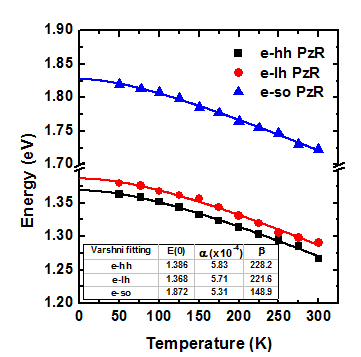 |
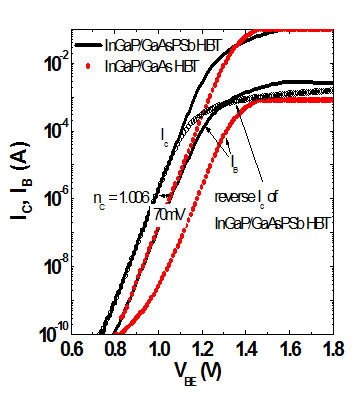 |
|
Fig. 1 Conduction band to heavy hole band, light hole band, and spin orbit band transition energies of GaAs0.64P0.19Sb0.17 as functions of temperature. |
Fig. 2 Gummel plots of the control InGaP/ GaAs SHBT and InGaP/GaAs0.57P0.28Sb0.15 DHBT. The hollow dot is the Ic of the reverse Gummel plot of the InGaP/GaAsPSb DHBT. |
|
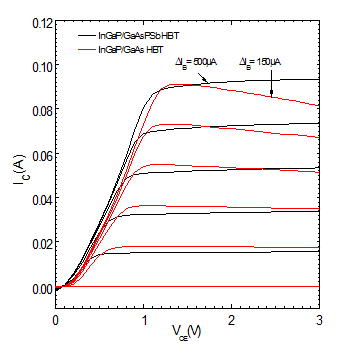 |
|
Fig. 3 Common emitter output characteristics of HBT with GaAsPSb base and HBT with GaAs base. |
|
|
|
 |
|
 |
|
| |
|
|
 |
|
 |
|
|
|